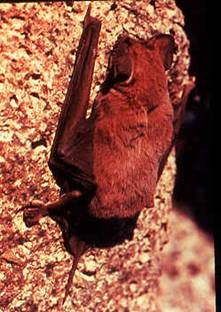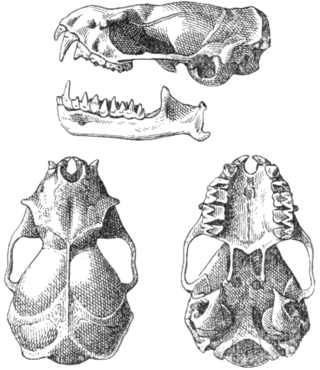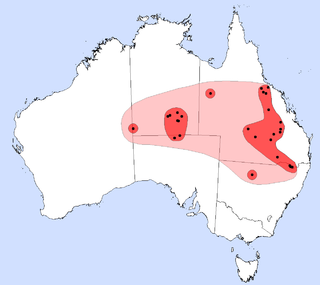
The Molossidae, or free-tailed bats, are a family of bats within the order Chiroptera. The Molossidae is the fourth-largest family of bats, containing about 110 species as of 2012. They are generally quite robust, and consist of many strong-flying forms with relatively long and narrow wings with wrinkled lips shared through their genus. Their strong flying form allows them to fly 60 miles per hour using tail winds and at altitudes over 10,000 feet. This makes them unique among bats, as they are the only bat family that withstands the elevation. They are widespread, being found on every continent except Antarctica. They are typically found in caves, abandoned mines, or tunnels.

Mormopterus is a genus of molossid microchiropterans, small flying mammals referred to as free-tailed bats. The genus has been the subject of several revisions, and the diversity of taxa centred on Australia were separated to a new genus Ozimops, and two monotypic genera, Setirostris and Micronomus. The species of Mormopterus, in this stricter sense, are only found in areas outside of Australia and West Papua.

Micronomus norfolkensis is a species of molossid bat, a family of flying mammals. The bat is endemic to Australia, where it occurs from southeastern Queensland to eastern New South Wales. They are the sole species of genus Micronomus and referred to by variations on east-coast free-tailed bat.

Beccari's free-tailed bat is a species of bat in the free-tailed bat family Molossidae found to Indonesia and Papua New Guinea. It can be found in several habitat types, including savanna, tropical moist forest, and fragmented and urban habitat. It roosts in trees, caves, and buildings in small colonies. This is a common species which is not considered to be threatened. The names Beccari's free-tailed bat or Beccari's mastiff bat once applied to populations in Australia.

Ozimops planiceps is a small bat in the family Molossidae, native to Australia and Indonesia.

The little goblin bat is a species of bat in the family Molossidae, the free-tailed bats. It is endemic to Cuba.

The inland broad-nosed bat is a species of vesper bat. They are endemic to Australia and widespread throughout the inland, especially in arid and semi-arid regions. This insectivorous microbat, measuring 12 centimetres (4.7 in) in length, roosts in tree hollows during the day and forages over woodland and water at night.

Nyctophilus geoffroyi is a vespertilionid bat. a flying nocturnal mammal found in Australia, The species is relatively common. They have been referred to as the lesser long-eared bat.
The Solomons mastiff bat is a species of bat in the family Molossidae. It is endemic to the Solomon Islands.

The white-striped free-tailed bat is a species of bat in the family Molossidae. Its echolocation calls are audible to humans, which is a characteristic found in only a few microbat species. The species was formerly classified as Tadarida australis.

Setirostris eleryi is a species of small insectivorous bat found in inland eastern Australia. It is the sole species of the molossid genus Setirostris, a name that refers to the coarse bristles on their faces. Earlier common names have referred to this unique feature, and the 'free-tail' that is a common feature of its microchiropteran family, the Molossidae; no single common name emerged during the taxonomic revisions that identified what was referred to as the bristle-faced freetail.
Ozimops loriae is a species of bat found in Australia and Papua New Guinea.
Ozimops ridei is a species of molossid bat found in eastern Australia.
Ozimops petersi, the inland free-tailed bat is a species of bat found in Australia.
Austronomus, known as Australasian free-tailed bats, is a molossid genus of microchiropterans. The two recognised species are the white-striped Austronomus australis, found in a wide distribution range across Australia, and the New Guinea species Austronomus kuboriensis.
Ozimops kitcheneri, the south-western free-tailed bat, is a species of molossid bat found in Southwest Australia. A small flying mammal, it forages in forests and woodlands for insects.
Ozimops is a genus of molossid bats found in Australia, Indonesia and Papua New Guinea.
Ozimops lumsdenae is a species of molossid bat found in Australia, the largest of the genus Ozimops.
Ozimops halli, also referred to as the Cape York free-tailed bat, is a species of molossid bat found at the Cape York Peninsula in Australia.









